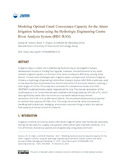Modeling Optimal Canal Conveyance Capacity for the Ahero Irrigation Scheme using the Hydrologic Engineering Centre River Analysis System (HEC-RAS)
Date
2023-12-11Author
Owino, Justus W.
Ong'or, Basil. T.
Mukolwe, Micah M.
Metadata
Show full item recordAbstract
Irrigation plays a critical role in addressing food security as envisaged in Kenya’s development blueprint, the Big Four Agenda. However, the performance of any open channel irrigation system is a function of its canal conveyance efficiency, among other factors. To overcome challenges with irrigation water conveyance at the Ahero Irrigation Scheme, a Hydrologic Engineering Centre River Analysis System (HEC-RAS) model was used to simulate the flow characteristics at the tail-end section of the canal network, covering a total length of 2.6 km. The study also consisted of a comparative review of an FAO-CROPWAT model estimation water requirement for rice. The manual estimation of the canal capacity in its unmaintained state revealed a discharge capacity of 0.228 m3/s, which was significantly lower than the minimum crop water demand requirement estimation of 0.3166 m3/s (a 28% water deficit). The simulated characteristics projected an optimal flow capacity of 0.583 m3/s. The study recommends canal maintenance (levelling bed undulations, dredging, and smooth concrete lining) to attain the optimal flow capacity at the tail end of the network.
URI
https://doi.org/10.14796/JWMM.C510https://www.chijournal.org/Journals/PDF/C510
http://ir-library.mmust.ac.ke:8080/xmlui/handle/123456789/2500
Collections
- Gold Collection [1026]

